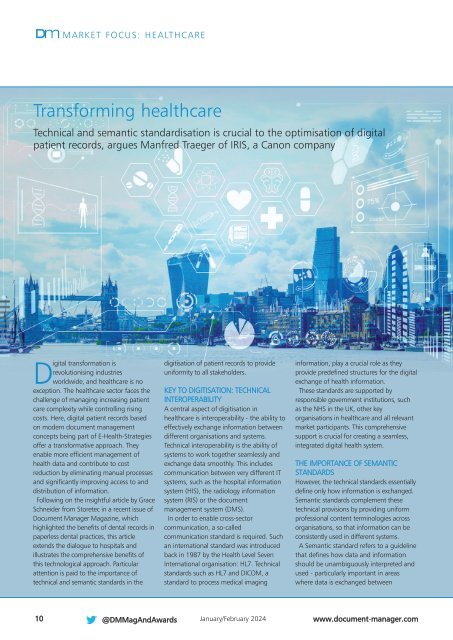DM Jan-Feb 2024
Create successful ePaper yourself
Turn your PDF publications into a flip-book with our unique Google optimized e-Paper software.
Dm MARKET FOCUS: HEALTHCARE<br />
Transforming healthcare<br />
Technical and semantic standardisation is crucial to the optimisation of digital<br />
patient records, argues Manfred Traeger of IRIS, a Canon company<br />
Digital transformation is<br />
revolutionising industries<br />
worldwide, and healthcare is no<br />
exception. The healthcare sector faces the<br />
challenge of managing increasing patient<br />
care complexity while controlling rising<br />
costs. Here, digital patient records based<br />
on modern document management<br />
concepts being part of E-Health-Strategies<br />
offer a transformative approach. They<br />
enable more efficient management of<br />
health data and contribute to cost<br />
reduction by eliminating manual processes<br />
and significantly improving access to and<br />
distribution of information.<br />
Following on the insightful article by Grace<br />
Schneider from Storetec in a recent issue of<br />
Document Manager Magazine, which<br />
highlighted the benefits of dental records in<br />
paperless dental practices, this article<br />
extends the dialogue to hospitals and<br />
illustrates the comprehensive benefits of<br />
this technological approach. Particular<br />
attention is paid to the importance of<br />
technical and semantic standards in the<br />
digitisation of patient records to provide<br />
uniformity to all stakeholders.<br />
KEY TO DIGITISATION: TECHNICAL<br />
INTEROPERABILITY<br />
A central aspect of digitisation in<br />
healthcare is interoperability - the ability to<br />
effectively exchange information between<br />
different organisations and systems.<br />
Technical interoperability is the ability of<br />
systems to work together seamlessly and<br />
exchange data smoothly. This includes<br />
communication between very different IT<br />
systems, such as the hospital information<br />
system (HIS), the radiology information<br />
system (RIS) or the document<br />
management system (<strong>DM</strong>S).<br />
In order to enable cross-sector<br />
communication, a so-called<br />
communication standard is required. Such<br />
an international standard was introduced<br />
back in 1987 by the Health Level Seven<br />
International organisation: HL7. Technical<br />
standards such as HL7 and DICOM, a<br />
standard to process medical imaging<br />
information, play a crucial role as they<br />
provide predefined structures for the digital<br />
exchange of health information.<br />
These standards are supported by<br />
responsible government institutions, such<br />
as the NHS in the UK, other key<br />
organisations in healthcare and all relevant<br />
market participants. This comprehensive<br />
support is crucial for creating a seamless,<br />
integrated digital health system.<br />
THE IMPORTANCE OF SEMANTIC<br />
STANDARDS<br />
However, the technical standards essentially<br />
define only how information is exchanged.<br />
Semantic standards complement these<br />
technical provisions by providing uniform<br />
professional content terminologies across<br />
organisations, so that information can be<br />
consistently used in different systems.<br />
A Semantic standard refers to a guideline<br />
that defines how data and information<br />
should be unambiguously interpreted and<br />
used - particularly important in areas<br />
where data is exchanged between<br />
10 <strong>Jan</strong>uary/<strong>Feb</strong>ruary <strong>2024</strong> www.document-manager.com<br />
@<strong>DM</strong>MagAndAwards
















